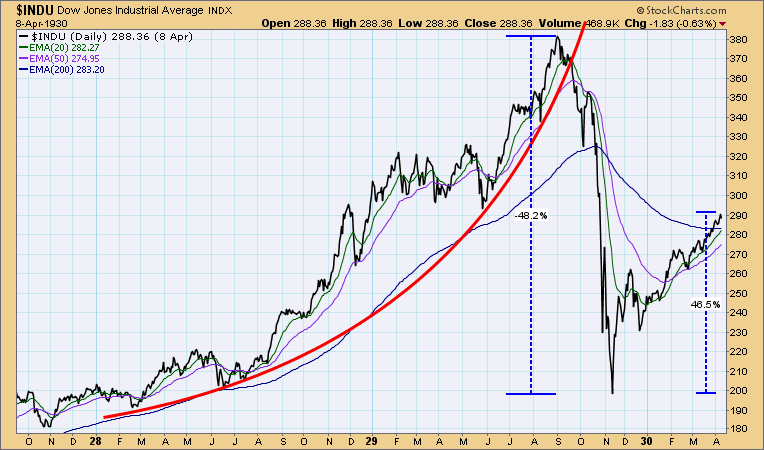
The Chinese stock market made news recently, dropping nearly -40% from its June top to a low in early July. With that market having bounced off the crash low, many are saying that the decline is over, but I think that assessment is premature. First of all, the advance prior to the crash was parabolic, moving up over +180% in about a year in an ever-steepening upward arc. And, although there is no guarantee, one thing we should always expect from parabolic price patterns is that they are most likely to collapse. Sure enough, that is exactly what happened to the Chinese market. The downside expectation for a parabolic collapse is that price will return to the level of the previous base, which we can see is down about -65% from the top.
As I looked at the China chart I was reminded to the 1929 Crash and wondered how much similarity there was. The chart of the 1929 Crash below is approximately the same time duration as the chart above. It is easy to see that the mighty advance of the Dow was more gradual than what happened with China. Even the Crash took longer, but it was violent nonetheless. What I find the most interesting at this point is the reaction rally of the Dow in 1929-1930 approached a +50% advance. The Chinese market is currently in a reaction rally phase, which could take it higher; however, we should keep in mind that lower prices are more likely.
I can't stop without showing the ultimate outcome of the 1929 Crash. On the chart below we can see that the Dow declined about -90% before the bear market hit bottom. I want to emphasize that I do this simply to complete the story, not to imply where China might be headed.
CONCLUSION: Parabolic advances nearly always break down, although it can be very hard to pick the exact top. What happens after the crash is also not easy to predict, but we should expect a decline back to the basing pattern that preceded the parabolic advance, unless new evidence causes us to think otherwise. The reaction rally following the initial crash can be quite encouraging and even profitable, but it would be wrong to assume that such a rally will lead to new highs that will exceed the parabolic top. In my opinion the Chinese stock market's current rally will falter soon and prices will head much lower, probably back to the 2014 lows. It is incomprehensible to me that such action in China will have no effect elsewhere in the global financial markets.
Subscribe to Carl's free blog and receive email whenever a new article is posted. See subscription links at the upper right corner of this page.
Technical analysis is a windsock, not a crystal ball.



